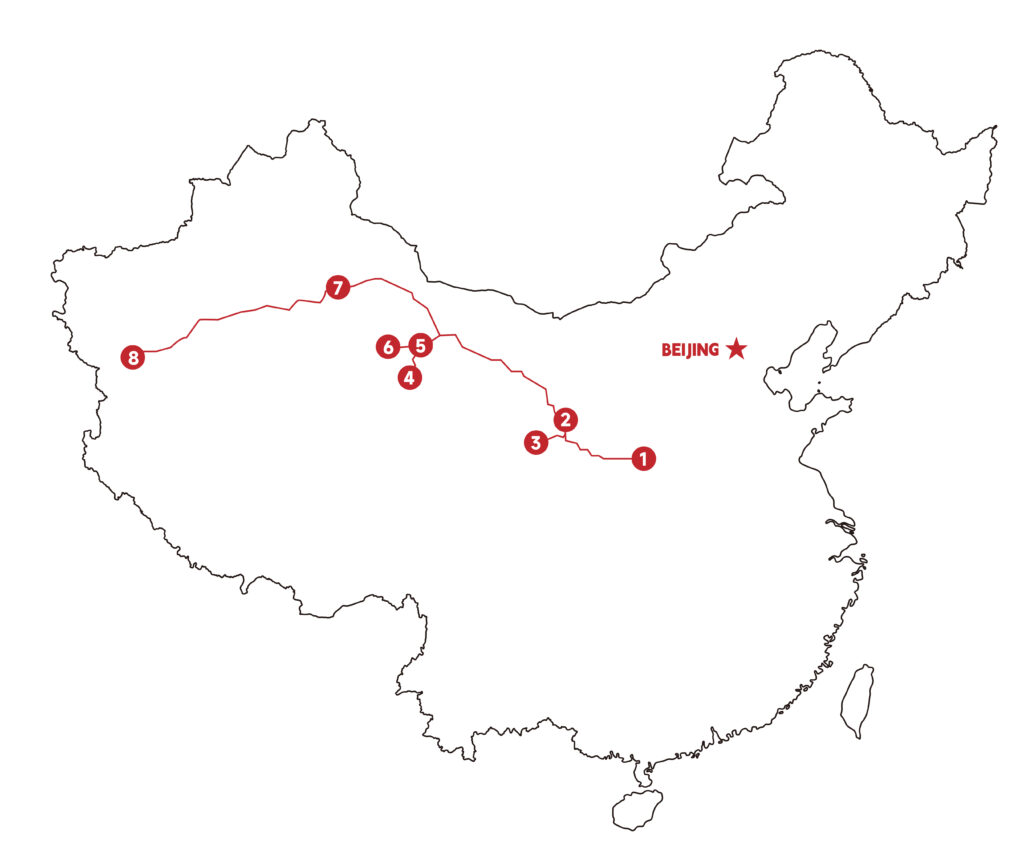THE SILK ROAD
Fall Semester
WELCOME TO CHINA, NOW LET'S GO TRAVEL
Trace a 2,050 miles section of the Silk Road, a legendary caravan trade route that has connected China with Europe since ancient times. A path which transported not only precious goods but technology, religion and culture between the east and west; in China’s “wild west,” you will discover historic treasures, oasis towns, Tibetan and Muslim nomads, and a thriving contemporary trade and cultural exchange between China and Central Asia. The Silk Road excursion is included in tuition and is a compulsory part of the fall semester. This itinerary is just to give you a taste of what’s to come and is subject to change.
The Silk Road Map
WELCOME TO CHINA,
NOW LET’S GO TRAVEL

1. XI’AN 西安
• Terracotta Warriors Museum
• Talk with an expert on Hui People in the Big Mosque
• Cycle on the Xi’an city wall
• Eat grilled mutton kebab
Walk in the steps of emperors. Capital of modern Shaanxi province, Xi’an has served as capital to 11 dynasties over a period of 4,000 years. Experience a bustling metropolis, luring foreign merchants and faiths, including Nestorian Christians, Muslims, Zoroastrians, Manicheans, and Buddhists. Bike the ancient city wall and visit the world-renowned Terracotta Warriors Museum, the sight of over 7,000 excavated terracotta soldiers, archers and horses.
2. LANZHOU 兰州
• Visit Linxia Xichuan Mosque
• Ride on a goat-skin boat across the Yellow River
• Eat world-famous Lanzhou beef lamian (hand-pulled noodles)
Indulge on the world-famous cuisine of Lanzhou noodles. The geological center of China and the capital of Gansu, Lanzhou has long been the key transport link between the Chinese heartlands and the Northwest. See the giant Water Wheels that used to be an essential irrigation tool and also take a ride on the goat-skin boat across the river at the city’s Yellow River Park.
3. XIA’HE 夏河
• Tour Labrang Monastery guided by a monk
• Hike to see the panoramic view of the Labrang Monastery
• Learn Tibetan dance and party with Tibetan nomads
Get a glimpse of Tibetan Buddhism. Perched at a height of 10,000 ft (3,048 m) in a mountain valley at the edge of the Tibetan plateau – that is now a part of Gansu – Xia’he is a significant Tibetan monastery town that attracts many devout Buddhist pilgrims to its Labrang Monastery every year. Have a talk with the locals, a mix of Hui, Tibetan, and Han Chinese, and explore the nomadic life of the surrounding mountains and grasslands.
4. MOGAO CAVES 莫高窟
• Be awed by what has been called the most fascinating repository of Buddhist art in China
• Explore the Caves of the Thousand Buddha
• Appreciate the watercolor murals of the caves and ceilings
See the Caves of the Thousand Buddhas. Protected by their relative isolation, the cave paintings at Dunhuang’s Mogao Caves form the most fascinating repository of Buddhist art in China. As one of the chief places of entry for Buddhist monks and missionaries from the kingdoms of Central Asia. Observe the walls and ceilings which were plastered with layers of cement and clay and painted with watercolor. See the work of over 700 years.
5. DUNHUANG CITY 敦煌
• Ride a camel across a branch of the Gobi Desert
Ride a camel in the Desert. A small oasis town on the Hexi Corridor, Dunhuang once was the last stop on the Silk Road. The granaries overflowed with wheat, and the town reckoned itself to be the safest and most prosperous place imaginable, priding itself on its trade-rout nickname of ‘little Peking’.” This will be your launching point to the nearby Mogao Caves, Crescent Lake, and Singing Sand Dunes.
6. CRESCENT MOON LAKE 月牙泉 SINGING SAND DUNES 鸣沙山
• Gaze across the endless desert
• Soak in the beauty of Crescent Moon Lake with the backdrop of the dunes
• Hear the dunes sing as the wind sweeps across them
Hear your footsteps sing. Just 3 miles (5 km) south of Dunhuang is the Crescent Moon Lake, a small (and getting smaller) freshwater lake that has been a vital source of water here for thousands of years. A solitary sand-jujube grows beside this miniature lake, half-enclosed by reeds. Soak up the beauty of water against the adjacent Singing Sand Dunes, which tower several hundred feet high while you listen to the noise made as the winds sweep across the sand dunes.
7. TURPAN 吐鲁番
• Dine among the grapevines in the origin of Chinese wine
• Explore the Jiaohe Ancient City Ruins
• Visit the lowest place in China-Ai Ding Lake
• Take a local donkey cart taxi
Journey to the lowest place in China. This oasis town on the northern Silk Road lies in the Turpan Depression – one of the lowest areas on earth – and is largely a Uygur settlement. Dine in a vineyard of a local Uygur family in this easy-going place, famous for its grapes, with mud-brick houses and dusty streets often covered with trellised vines. Escape the summer heat by hailing a local taxi, a donkey cart. After an afternoon of learning the locals dance moves, head to Ai Ding Lake (艾丁湖, meaning Moonlight Lake), the lowest place in China and the second lowest place in the world.
8. KASHGAR 喀什
• See one of the best examples of Islamic architecture in China- Aba Khoja Mausoleum
• Visit the largest mosque in Xinjiang Id Kah Mosque
• Experience local Uyghur daily life
Feel the influence of varying cultures and empires. In the far west of Xinjiang, the Silk Road town of Kashgar lies at the foot of the Pamir mountains, with the Taklamakan Desert to the east. Being the meeting point of the northern and southern Silk Roads and the gateway to the West, it was once a place of great significance as a melting pot of widely varying cultures and empires. Kashgar has been under the rule of the Chinese, Turkic, Mongol, and Tibetan empires. Today, 70 percent of its population of over 300,000 are Uyghur, and you are sure to be swept up in the charm of a busy market town and transport hub.
